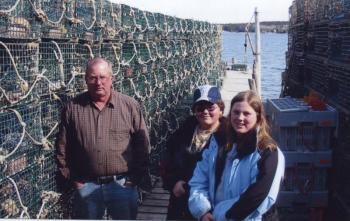Harley Wallace

Finding Friendship Oral History Project
The Finding Friendship Oral History Project is a joint effort of the Friendship Museum and the Friendship Village School, directed by Sally Merrick, museum volunteer, and Gaylea Hynd, teacher. In 2003-2004 sixth grade students conducted taped interviews of three generations of lobstermen and women, as well as others associated with the lobstering industry. Printed copies of the interviews and CDs of the printed transcripts are available at the Friendship Museum in Friendship, Maine.
Eleanor Barlow
Harley Wallace, born on May 21, 1951, is a lifelong resident of Friendship, Maine, where his family has deep roots for four generations. Harley has lived in Friendship his entire life and comes from a family with a long tradition of lobstering spanning four generations. He has three sisters and one brother and is the father of two children with one grandchild. Harley began his lobstering journey at the age of six, accompanying his father on the boat. With two children and one grandchild, Harley has dedicated most of his life to lobstering, amassing an impressive 46 years of experience in the industry. He has explored various laboring jobs related to the ocean, excluding blueberry raking and potato digging, and has cultivated hobbies centered around hunting and fishing.
Scope and Content Note
In an interview with Suzanne and Kristy on September 30, 2003, conducted at Harley Wallace's home, the seasoned lobster fisherman shares insights into his life and career. He expresses a genuine passion for the job, which ultimately led him to become a lobsterman himself. As the captain of his lobster boat, named Miss Kristin after his daughter, Harley's primary responsibility is to haul and set traps. He works alongside Doug Wilshire, who assists with baiting and banding the lobsters. The interview sheds light on various aspects of Harley's lobstering operation. His boat, a 34-foot fiberglass vessel, is equipped with essential tools such as a fathometer, radar, and compass. He uses four-foot wire traps, primarily colored green, with the exception of one trap that is yellowish-green. The distinct buoy colors, orange and green, help him identify his traps in the vast ocean. Harley shares details about his daily routine, mentioning that he typically heads out at 5:00 a.m. and returns by noon, covering a distance of four to six miles. He hauls a couple of hundred traps during this time, highlighting the physically demanding nature of his work. Lobstering in various weather conditions, including fog, rain, and thunderstorms, is a regular part of his job. Throughout his lobstering career, Harley has witnessed significant changes in the industry. Automation has brought advancements such as automatic haulers and winches, while traditional wooden traps and buoys have been replaced by wire traps and styrofoam buoys, respectively. When asked about his most memorable fishing experiences, Harley mentions catching blue and yellow spotted lobsters, as well as a notable night when his crew landed 5,000 pounds of shrimp. Harley jokingly states that he intends to retire at the age of 80. As the interview concluded, he expresses his contentment with the opportunity to share his knowledge and experiences with the interviewers, reflecting his humble and hardworking nature.
Please Note: The oral histories in this collection are protected by copyright and have been created for educational, research and personal use as described by the Fair Use Doctrine in the U.S. Copyright law. Please reach out Voices@noaa.gov to let us know how these interviews are being used in your research, project, exhibit, etc. The Voices staff can help provide other useful resources related to your inquiry.
The NOAA mission is to understand and predict changes in climate, weather, oceans, and coasts, to share that knowledge and information with others, and to conserve and manage coastal and marine ecosystems and resources. The Voices Oral History Archives offers public access to a wide range of accounts, including historical materials that are products of their particular times, and may contain offensive language or negative stereotypes.
Voices Oral History Archives does not verify the accuracy of materials submitted to us. The opinions expressed in the interviews are those of the interviewee only. The interviews here have been made available to the public only after the interviewer has confirmed that they have obtained consent.
